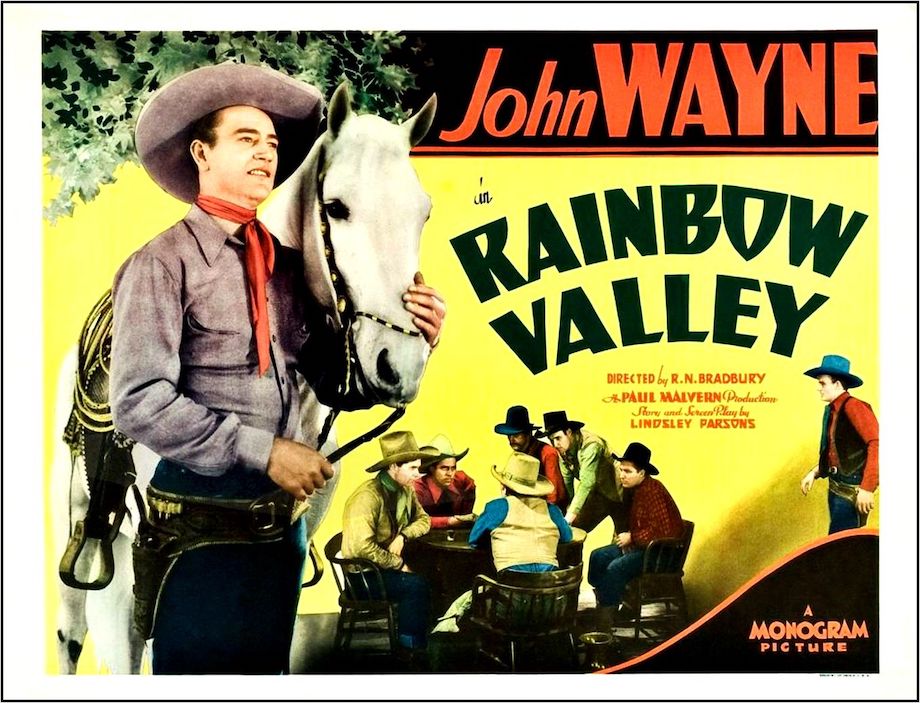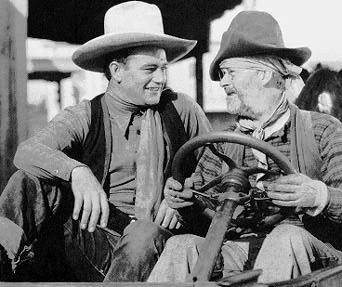Rainbow Valley (1935) Lone Star, Dir: Robert N. Bradbury, b/w, 52m
Cast: John Wayne, Lucille Brown, George Hayes, Leroy Mason, Lloyd Ingraham, Buffalo Bill Jr.
On the way to Rainbow Valley JW, as John Martin, encounters the proper “Gabby”, the one we all know and love and in full ‘old-timer’ mode, who asks him for some water for “Nellie”. Now the bad news. “Nellie” is an automobile. Yep, we’re back doing the time-warp again. There’s even more bad news. Lucille Brown is back as well. I’m not sure I’m going to make it to the end of this one.

Unless Duke is the sheriff in one of these Lone Star efforts then it’s usually a bit difficult to work out exactly what he does for a living. After “Nellie” is nearly robbed by a gang of outlaws on account of the car being the stagecoach – again – the local townspeople decide to petition the governor to send someone to their town and bring a bit of law and order. And that man, of course, is Mr. John Wayne himself.
In true secret-agent government undercover man style, JW duffs up one of the outlaws who tried to hold up “Nellie”. Postmistress Eleanor, played by Ms. Black, isn’t too impressed with Duke’s fisticuffs, obviously missing the fact that JW has to be the good guy on account of he’s wearing a white hat.
The outlaw gang, led by the head villain Rogers, played by LeRoy Mason, are attempting to run off a bunch of prospector’s by keeping the law out of Rainbow Valley and also stopping the building of a highway that would make it easier for them to move their findings from the mine.
Rogers and the gang figure by doing all of this the prospectors will become dispirited and sell their land at a knock-down price to the varmints what want it all for theyselves. I have to admit the plan comes across as rather tedious and labyrinthine when all they’ve really got to do is just murder everyone in a ten-mile radius then keep quiet about the whole thing – which is why I probably would never have made the grade as a professional hornswaggling varmint.
JW is offered the job of overseeing the construction of the road which won’t be too much of a stretch for him because by sheer luck – and narrative convenience – it so happens he majored in engineering, him being a college kid and all that.
His first day on the job turns out to be quite exciting, what with Rogers and the boys attempting to run the road workers off and eventually being repelled by “Gabby” driving “Nellie” whilst indiscriminately throwing sticks of dynamite in their direction. I think the dynamite must possess magical qualities of some kind as it seems to explode without being lit first.
The print I watched wasn’t all that good but I’m pretty sure I’m correct in saying that there are a number of African Americans working in the road gang alongside their white colleagues.
This either demonstrates a heretofore unknown example of a willingness for people on either side of the racial divide to work together in peaceful harmony, or the black roadies have been able to get time off from working on the plantation to help out their white kin. Whether they want to or not.
There’s a whole other subplot going on in which Rogers and the boys are trying to get one of their own out of jail.
Rogers substitutes a petition the townsfolk have put together in order to get help from the government in building the road with a different petition for the release of their incarcerated boss, a certain Butch Galt.
You just know with a name like Butch he won’t be dropping into town to make nice with the local inhabitants. The plot thickens when Butch tells the boys he and John Martin were cellmates in the prison and he’ll have a word with him to make sure the road never gets built.
Sure enough, to all intents and purposes, it looks as though JW is actually in cahoots with Butch, but we know better, don’t we? The ignorant townsfolk – and I mean that in every sense of the word – feel betrayed by JW, belatedly galvanising themselves into finally taking action against Butch and the boys.
It kind of makes you wonder why they didn’t do that way before JW sauntered onto the scene, particularly as it looks as though they outnumber the bad guys by about thirty to one.
The Gabster gets written confirmation that JW is really a government agent and then has to go call off the mob who are out to get Duke and the outlaw gang. Unfortunately, his car won’t start so Gabby is forced to hitch it up to a couple of horses as he and Eleanor race off to rescue JW.
Intriguingly, the car still makes the same noise it made when it was powered under it’s own steam. Either that or Gabby and the lady are catching hell from sitting behind those horses.
Ultimately there’s a massive shootout between the opposing forces. It’s the biggest climactic confrontation to feature in all of the 1930s low-budget JW films I’ve reviewed so far.
The fight comes to an end when Butch accidentally butchers his own men by blowing them up with the dynamite he intended to use against the townies. The explosion also serves to help complete the road, which is a nice coincidence.
JW and the lady finally lock lips in the final reel so all’s well that ends well. At some point prior to this, Lucille Black as Eleanor tells JW “I want to apologise for they way I’ve been acting towards you.” Hey lady. How about apologizing for your acting to the rest of us?
Not bad. Not good but not that bad either. Check it out if you’ve got nothing better to do.

